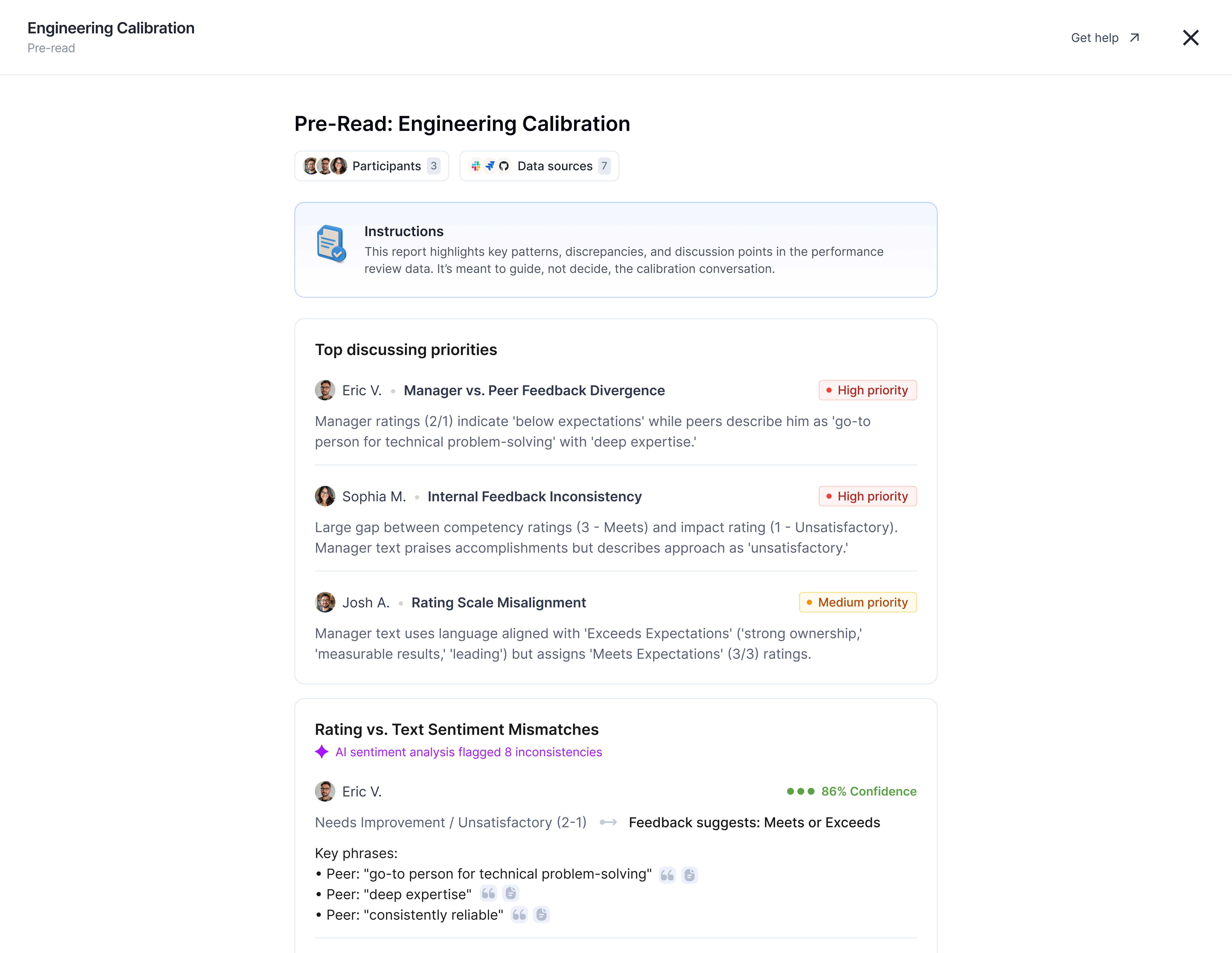 Performance Review Calibrations
Performance Review Calibrations
Calibrations that are 3x faster and fairer
Pre-reads that highlight discrepancies and flag biases, so calibration meetings are grounded in truth, not politics.




































































AI-powered calibration pre-reads
Before calibration meetings, committee members receive comprehensive pre-reads that identify discrepancies, flag potential biases, and surface discussion areas.



Whoa the calibration reports! What an unexpected moment of delight 😅
Stas Johnson-Chyzhykov
COO @ Rho
Setting ratings is a breeze
Windmill's live calibration dashboard allows committee members to collaborate and adjust ratings in real-time.

How it works
Windmill continuously gathers performance context 


 throughout the year, then automatically generates calibration materials after reviews are submitted.
throughout the year, then automatically generates calibration materials after reviews are submitted.



 throughout the year, then automatically generates calibration materials after reviews are submitted.
throughout the year, then automatically generates calibration materials after reviews are submitted. 1. Continuous context gathering
Windmill collects performance data year-round from your tools, 1:1s, and team feedback.
2. AI detects discrepancies
Windmill instantly identifies similar performers with different ratings, manager rating patterns, and potential biases.
3. Pre-reads generated
Committee members receive comprehensive briefs with rating distributions, flagged outliers, and discussion areas.
4. Focused calibration meetings
Leaders spend time making data-driven decisions instead of debating, resulting in 75%+ shorter calibration sessions.
Why traditional calibrations fail
Traditional calibration meetings are time-consuming, emotionally charged, and can actually introduce the biases they're meant to eliminate.

Time-consuming marathons
Organizations with 100+ employees spend entire weeks in calibration meetings, reducing time for real work.

Outdated data
By calibration time, performance data is often months old and no longer relevant to current performance.

Paradoxical bias introduction
Calibration can introduce new biases when persuasive communicators influence outcomes over data.

Manager defensiveness
Calibration becomes adversarial when managers fight for their team's ratings without data to back them up.

Frequently asked questions
What are the most important pain points you solve related to performance reviews?
The main pain points Windmill helps address are: 1) Reducing the time and effort for executives and managers to complete reviews, 2) Ensuring documentation is maintained, which is critical for performance management and compliance issues, 3) Making timely performance management possible, 4) Providing visibility at senior levels across teams and ensuring employees' work is recognized and managers know what their teams are doing.
Can Windy collect 360 or peer-to-peer feedback as part of performance reviews?
Yes, Windy can be deployed to collect self-reviews, peer feedback, and cross-team feedback as part of a formal performance cycle—all within Slack. Employees can even nominate peers for feedback through Slack, and Windy will manage the communication and collection of that feedback, making the process easy and lightweight for everyone involved.
How much time does it take for a manager to conduct a performance review with Windmill compared to traditional tools?
Windmill aims to allow managers to complete a full performance review in as little as six minutes, provided there is enough underlying data from system. The AI collects and organizes all needed information, making the process much faster than traditional, more manual methods.
Can the platform do ranking or ratings, or a nine-box grid for calibration and performance review?
Yes, the platform supports rating and calibration processes. Managers select ratings on a customizable scale which influence the tone of the performance review draft. The calibration view allows you to adjust employee placement and rating, justify changes, and see divergence between ratings and review text. Sentiment analysis and tone-matching in reviews are incorporated.
How customizable is the performance review process?
The review cycle timing is fully customizable—you can set start/end dates and deadlines. You can include or omit self-reviews, peer reviews, or upward feedback as needed, and customize all of the questions. The number and type of rating scales are also customizable, and company core values can be reflected and evaluated within the system.
How does Windmill approach the length and detail of performance reviews? Can there be controls over how much detail is included?
Our approach is to supplement data aggregation and AI summarization with human input; managers still must review, edit, and assign a rating to the data presented, so there's always a human layer in the process.
How does Windmill make performance management and feedback collection more efficient or effective than other tools?
By integrating deeply with tools like Slack and Google Calendar, Windmill makes it easy to build agendas, take notes, collect structured and unstructured feedback, and synthesize activity across different business systems. Its Slack-based AI agent suggests topics, organizes context, and saves managers from manual information-gathering, creating high manager and employee engagement.